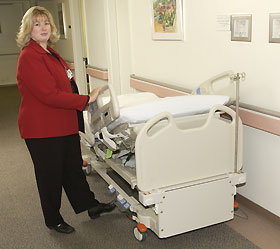For more archives, go to the Advance Archive/Search Page.
New Beds At Dempsey Hospital
Improve Patient Safety, Care
Twenty new, state-of-the-art hospital beds arrived at the John Dempsey Hospital this summer and are now in use, the first shipment of a total of 80 ordered as part of the hospital's initiative to improve patient safety and care.
Nicholas Noyes, director of clinical engineering at the Health Center, says a hospital bed is much more than a means to good night's sleep; it's where nurses and physicians provide much of the care for hospitalized patients, and where patients spend most of their time.

|
Shannon Rankin, a nursing manager, demonstrates one of the new high-tech beds at the Health Center.
The beds are designed to improve both safety and patient care. |
"Patient safety has become a hot issue nationwide, and it is our highest priority," Noyes says. "Our goal is to be the safest hospital in the state. These beds will help us deliver more effective and efficient care to our patients and reduce the risk of injuries to our caregivers."
Manufactured by Hill-Rom, the beds incorporate innovative ways to improve patient care and safety. Zones of continuous low air pressure in the mattress help reduce the risk of skin ulcers, a common problem among patients who require longer hospital stays; and narrower side-rail gaps and improved mattress design help keep patients secure in their beds. The beds' low height allows patients to move easily in and out of the bed, reducing the risk of falls; and special alarms also help reduce falls, by alerting clinical staff if a patient tries to leave the bed without assistance.
Other features include night lights integrated into the beds; automatic chair positioning, allowing patients to slide easily from bed to wheelchair; a foot and heel protection feature that keeps patients from sliding down in the bed; and extension capabilities to accommodate tall patients.
Caregivers applaud the bed's unique air mattress design that includes a patient-turning feature to help position patients for examination or linen changes. It even has a built in scale, eliminating for need to move patients to be weighed.
"These features reduce the risk of back and other injuries for nurses, doctors, and technicians who have to move and lift patients routinely, and are less disruptive and less likely to cause discomfort to patients," says Shannon Rankin, nursing manager. "Patients, nurses, doctors, even visitors love these beds."
The beds were selected by a hospital-wide taskforce that included Noyes and staff from clinical nursing, housekeeping, and environmental health and safety. Each bed costs about $8,000. They will be delivered in installments over the next few months.
"These beds will offer a good night's sleep in many ways," says Noyes. "We can't necessarily make a hospital stay fun, but we can make it more comfortable and, most importantly, safer."

